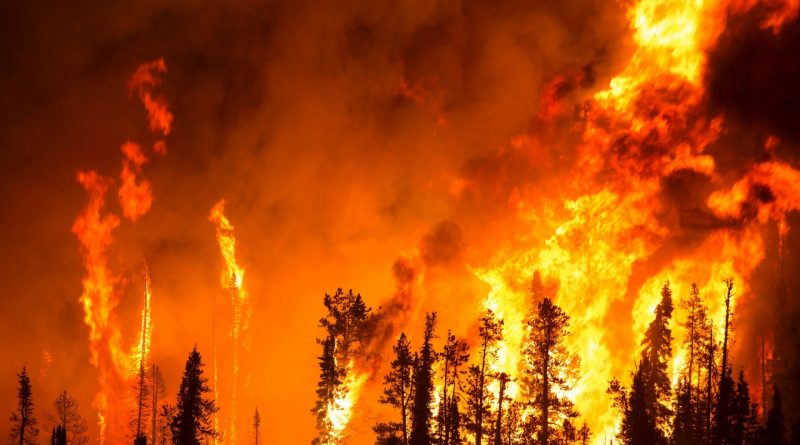Is It Too Late?
When the deadly California “Camp Fire” closed in on the town of Paradise in November 2018, Nurse Nichole Jolly1 helped safely evacuate patients at a breakneck pace. Then with flames approaching the parking lot, she jumped in her car to try to make her own escape. Sparks and flames hit the side of her car, then the car started to fill up with smoke. She got out and ran to another car, with the seat of her pants on fire. With smoke filling that car too, and her own car a mass of flames, she ran uphill. Just then a fire engine arrived, wrapped her in a fire blanket, and took her to safety. The fire destroyed her home, but she was grateful to be alive.
It takes multiple factors to make a wildfire one of the most deadly in history, but experts agree that extreme drought, caused or exacerbated by climate change, was a key factor in all of the deadly California wildfires in 2018. The Camp Fire killed more than 85 people and burned more than 13,000 homes. Total damage was $16.5 billion. It was only one of more than 8,000 wildfires in California in 2018, which burned more than 1.8 million acres.
Rising Water
Chris Brunet 2 lives in a home on stilts on a Louisiana island. His home has been in his family for seven generations. Now he’s being forced to leave the island permanently because of rising sea levels caused by climate change and erosion. The government plans to relocate him and his community to a new inland town, after they’ve lived and worked on the water for their entire lives.
Louisiana is losing an area the size of a football field every hour. The coastal Isle de Jean Charles, where Brunet lives, was 22,000 acres in 1955 and now is less than 320 acres. State officials have announced that all of the residents, most of whom are members of the Biloxi-Chitimacha-Choctaw Indian tribe, must evacuate permanently. They are one hurricane away from obliteration. Some see them as the first true climate refugees of the United States.
Is it too late? It’s too late to save the 85 lives or 13,000 homes lost in that California wildfire. It’s too late for Chris Brunet to save the island home where his family has lived for generations. For the 24 million current worldwide climate refugees, it’s too late to keep their lives from being totally overturned. For all those killed in catastrophic typhoons, cyclones, and hurricanes, it’s too late.
What is still possible?
On the other hand, it’s not too late to keep much of the earth habitable by humans. It’s not too late to prevent billions of people from dying. It’s not too late for us as a species to come together and say that our survival, and the survival of many other living things, is more important than allowing corporate greed to seek unlimited profits at our expense. It’s not too late to reject business-as-usual. It’s not too late to decide that everyone matters. It’s not too late to find and adopt sustainable ways of living more lightly on the earth.
The UN IPCC report by some of the world’s leading climate scientists released last fall examined what the difference would be between global temperatures rising 1.5°C above pre-industrial levels and rising 2°. The differences are striking in the levels of drought, flooding, extreme heat, species extinction, ocean fish yields, food insecurity, health problems and mortality. We will experience severe consequences of climate change even at 1.5°, but they will be much worse at 2°.
Can we do it? It’s possible, but not without dramatic shifts in how the world generates and uses energy, feeds itself, provides transportation, and other key factors. To limit temperature rise to 1.5° the world will need to reduce greenhouse gas emissions by 45% by 2030. The know-how for this exists, but the political will and public pressure for it do not yet exist.
A 2° rise would cause a horrible climate catastrophe, but we are headed for a catastrophe twice that bad. If we don’t make big changes, current practices and trends will raise the temperature 4°C – which would be unimaginably worse. Even if we miss the 1.5 ° target, we will need an unprecedented collaboration to stay within a 2° rise. As bad as it would be, a 2° rise would be better than a 2.5° rise, and so forth. So we aren’t going to get to give up. Every bit of change we can make that reduces the increase in global temperatures will save lives and reduce suffering.
Window of time
I think we need to face that the situation is already worse than we realize, especially when viewed from the perspective of people of color around the world. We should probably also realize that things are going to get much worse – worse than most of us have yet faced. And yet, we are living in the window of time when we still have an opportunity to prevent even more disastrous effects of climate change. We have an unprecedented opportunity to make a difference. How those of us who are now alive respond, will determine the future for countless generations of all living things.
Is it to late? Yes, and no. There’s no time for complacency, but there is time to act.
1 https://abcnews.go.com/US/thought-gonna-die-nurses-harrowing-escape-camp-fire/story?id=59138066
2 https://www.businessinsider.com/isle-de-jean-charles-climate-change-refugees-2018-4
